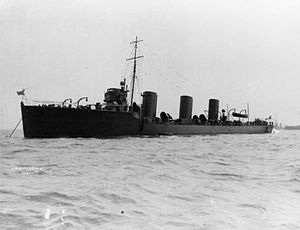Loading AI tools
Destroyer of the Royal Navy From Wikipedia, the free encyclopedia
HMS Cossack was a Tribal-class destroyer of the Royal Navy launched in 1907 and sold in 1919.
 HMS Cossack | |
| History | |
|---|---|
| Name | HMS Cossack |
| Builder | Cammell Laird, Birkenhead |
| Laid down | 13 November 1905 |
| Launched | 16 February 1907 |
| Commissioned | April 1908 |
| Fate | Sold for scrap, December 1919 |
| General characteristics [1] | |
| Class and type | Tribal-class destroyer |
| Displacement |
|
| Length | |
| Beam | 26 ft (7.9 m) |
| Draught | 8 ft 7 in (2.62 m) |
| Propulsion |
|
| Speed | 33 kn (38 mph; 61 km/h) |
| Range | 1,325 nmi (2,454 km; 1,525 mi) at 15 kn (28 km/h; 17 mph) |
| Complement | 72 |
| Armament |
|
HMS Cossack was one of five Tribal-class destroyers ordered as part of the 1905–06 shipbuilding programme.[2] While the Admiralty laid down the basic requirements of an oil-fuelled, steam turbine-powered ship with a speed of 33 knots (61 km/h; 38 mph), a range of 1,500 nautical miles (2,800 km; 1,700 mi) at cruising speed and an endurance of eight hours at full speed, the details of the design of individual ships was left to the builders, which meant that individual ships of the class differed significantly from each other. Cammell Laird's design was powered by steam turbines rated at 14,000 shaft horsepower (10,000 kW) fed by five boilers to drive three propeller shafts, and had three large funnels. Armament was the specified three 12 pounder (3 inch, 76 mm) 12 cwt guns[lower-alpha 1], two side by side on the ship's forecastle and one aft, with two 18 in (450 mm) torpedo tubes.[3][4][5]
Cossack was laid down on 13 November 1905 and launched on 16 February 1907.[6] After successfully undergoing trials[7] where she reached a speed of 34.619 knots (64.114 km/h; 39.839 mph),[2] Cossack was commissioned in April 1908.[6]
Shortly after Cossack entered service, it was decided to strengthen the armament of the first batch of Tribals by adding another two 12 pounder guns, this being done in 1909.[4][8] Cossack was considered by her Captain to be a poorer sea boat than River-class destroyers,[lower-alpha 2] but a better gun platform.[8]
In 1909, following a re-organisation of the Royal Navy's Home and Atlantic Fleets, Cossack was part of the First Destroyer Flotilla of the Home Fleet.[10] 1910, Cossack remained part of the First Flotilla in 1910.[11] By 1913, she had joined the 4th Destroyer Flotilla,[11] based at Portsmouth.[12] In October that year, the Tribals were officially designated the F class, and as such the letter "F" was painted on Cossack's bows.[4][5] While still a part of the 4th Flotilla in January 1914,[13] but by February had transferred to the 6th Destroyer Flotilla.[14]
During the First World War she served in the North Sea and the English Channel with the 6th Destroyer Flotilla.
On 23 August 1914, Cossack was involved in a collision with her sister Tribal-class destroyer, Ghurka.[15] In October 1914, Cossack was one of a number of warships of the Dover Patrol that were deployed to help support Belgian ground forces during the Battle of the Yser, with all available ships being used to carry out shore bombardment operations. At one stage, on 20 October 1914, after the destroyer Amazon was damaged by German shellfire, Rear Admiral Horace Hood transferred his flag to Cossack.[16][17]
On the night of 26/27 October 1916, German torpedo boats of their Flanders Flotilla carried out a large scale raid into the English Channel, hoping to attack the drifters watching the anti-submarine nets of the Dover Barrage, and to sink Allied shipping in the Channel. Cossack was one of six Tribal-class destroyers waiting at readiness in Dover harbour, and when the Germans attacked the drifters and sank the supporting destroyer HMS Flirt, they were ordered to intervene. The six destroyers became separated, and while several of them encountered groups of the German torpedo boats on their return leg, with HMS Nubian being badly damaged by a German torpedo and Amazon and Mohawk sustaining lesser damage from German gunfire, Cossack did not engage the German ships.[18]
On 1 July 1917, Cossack collided with the transport SS The Duchess near Eastbourne. Cossack's depth charges exploded as a result of the collision, sinking The Duchess and blowing off Cossack's stern.[9][19][20] Cossack was towed to Dover for repair.[21]
On 16 September 1918, a fire started in one of the magazines of the newly delivered monitor HMS Glatton. In order to prevent an explosion that could affect a nearby ammunition ship, it was decided to sink Glatton. Cossack fired two torpedoes at Glatton, one of which failed to detonate, while the second failed to defeat Glatton's anti-torpedo bulge.[22][23][24] In the end, Glatton was sunk by 21 inch (533 mm) torpedoes from the destroyer HMS Myngs.[22]
Cossack was sold to the shipbreakers Thos. W. Ward on 12 December 1919 for scrapping at their Preston, Lancashire, works.[6][25]
| Pennant number[25] | Date |
|---|---|
| H09 | 1914 |
| D02 | September 1915 |
| D19 | January 1918 |
Seamless Wikipedia browsing. On steroids.
Every time you click a link to Wikipedia, Wiktionary or Wikiquote in your browser's search results, it will show the modern Wikiwand interface.
Wikiwand extension is a five stars, simple, with minimum permission required to keep your browsing private, safe and transparent.